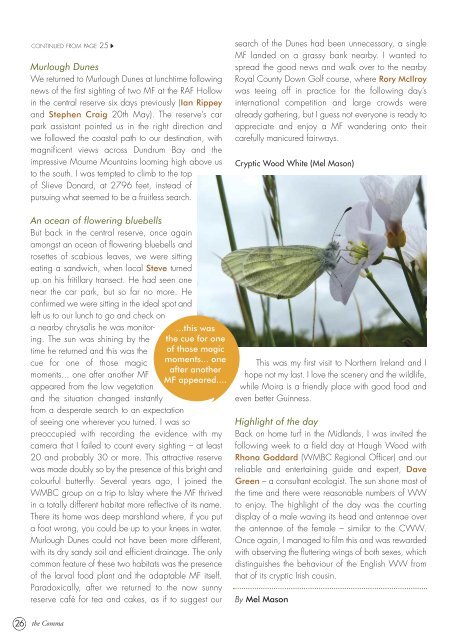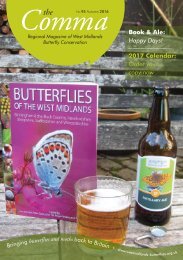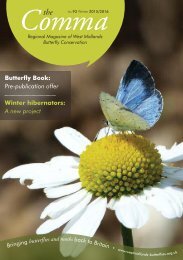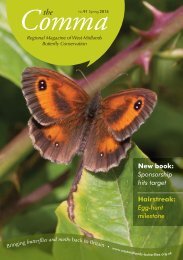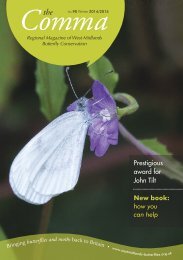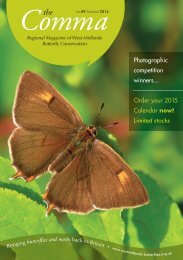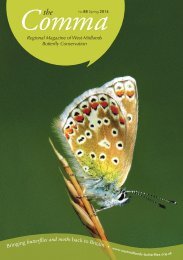Comma No92 Autumn 2015
32 page Butterfly Magazine designed for the West Midlands branch of Butterfly Conservation
32 page Butterfly Magazine designed for the West Midlands branch of Butterfly Conservation
Create successful ePaper yourself
Turn your PDF publications into a flip-book with our unique Google optimized e-Paper software.
CONTINUED FROM PAGE 25<br />
Murlough Dunes<br />
We returned to Murlough Dunes at lunchtime following<br />
news of the first sighting of two MF at the RAF Hollow<br />
in the central reserve six days previously (Ian Rippey<br />
and Stephen Craig 20th May). The reserve’s car<br />
park assistant pointed us in the right direction and<br />
we followed the coastal path to our destination, with<br />
magnificent views across Dundrum Bay and the<br />
impressive Mourne Mountains looming high above us<br />
to the south. I was tempted to climb to the top<br />
of Slieve Donard, at 2796 feet, instead of<br />
pursuing what seemed to be a fruitless search.<br />
search of the Dunes had been unnecessary, a single<br />
MF landed on a grassy bank nearby. I wanted to<br />
spread the good news and walk over to the nearby<br />
Royal County Down Golf course, where Rory McIlroy<br />
was teeing off in practice for the following day’s<br />
international competition and large crowds were<br />
already gathering, but I guess not everyone is ready to<br />
appreciate and enjoy a MF wandering onto their<br />
carefully manicured fairways.<br />
Cryptic Wood White (Mel Mason)<br />
An ocean of flowering bluebells<br />
But back in the central reserve, once again<br />
amongst an ocean of flowering bluebells and<br />
rosettes of scabious leaves, we were sitting<br />
eating a sandwich, when local Steve turned<br />
up on his fritillary transect. He had seen one<br />
near the car park, but so far no more. He<br />
confirmed we were sitting in the ideal spot and<br />
left us to our lunch to go and check on<br />
a nearby chrysalis he was monitoring.<br />
The sun was shining by the the cue for one<br />
...this was<br />
time he returned and this was the of those magic<br />
cue for one of those magic<br />
moments... one<br />
after another<br />
moments... one after another MF<br />
MF appeared....<br />
appeared from the low vegetation<br />
and the situation changed instantly<br />
from a desperate search to an expectation<br />
of seeing one wherever you turned. I was so<br />
preoccupied with recording the evidence with my<br />
camera that I failed to count every sighting – at least<br />
20 and probably 30 or more. This attractive reserve<br />
was made doubly so by the presence of this bright and<br />
colourful butterfly. Several years ago, I joined the<br />
WMBC group on a trip to Islay where the MF thrived<br />
in a totally different habitat more reflective of its name.<br />
There its home was deep marshland where, if you put<br />
a foot wrong, you could be up to your knees in water.<br />
Murlough Dunes could not have been more different,<br />
with its dry sandy soil and efficient drainage. The only<br />
common feature of these two habitats was the presence<br />
of the larval food plant and the adaptable MF itself.<br />
Paradoxically, after we returned to the now sunny<br />
reserve café for tea and cakes, as if to suggest our<br />
This was my first visit to Northern Ireland and I<br />
hope not my last. I love the scenery and the wildlife,<br />
while Moira is a friendly place with good food and<br />
even better Guinness.<br />
Highlight of the day<br />
Back on home turf in the Midlands, I was invited the<br />
following week to a field day at Haugh Wood with<br />
Rhona Goddard (WMBC Regional Officer) and our<br />
reliable and entertaining guide and expert, Dave<br />
Green – a consultant ecologist. The sun shone most of<br />
the time and there were reasonable numbers of WW<br />
to enjoy. The highlight of the day was the courting<br />
display of a male waving its head and antennae over<br />
the antennae of the female – similar to the CWW.<br />
Once again, I managed to film this and was rewarded<br />
with observing the fluttering wings of both sexes, which<br />
distinguishes the behaviour of the English WW from<br />
that of its cryptic Irish cousin.<br />
By Mel Mason<br />
26<br />
the <strong>Comma</strong>


